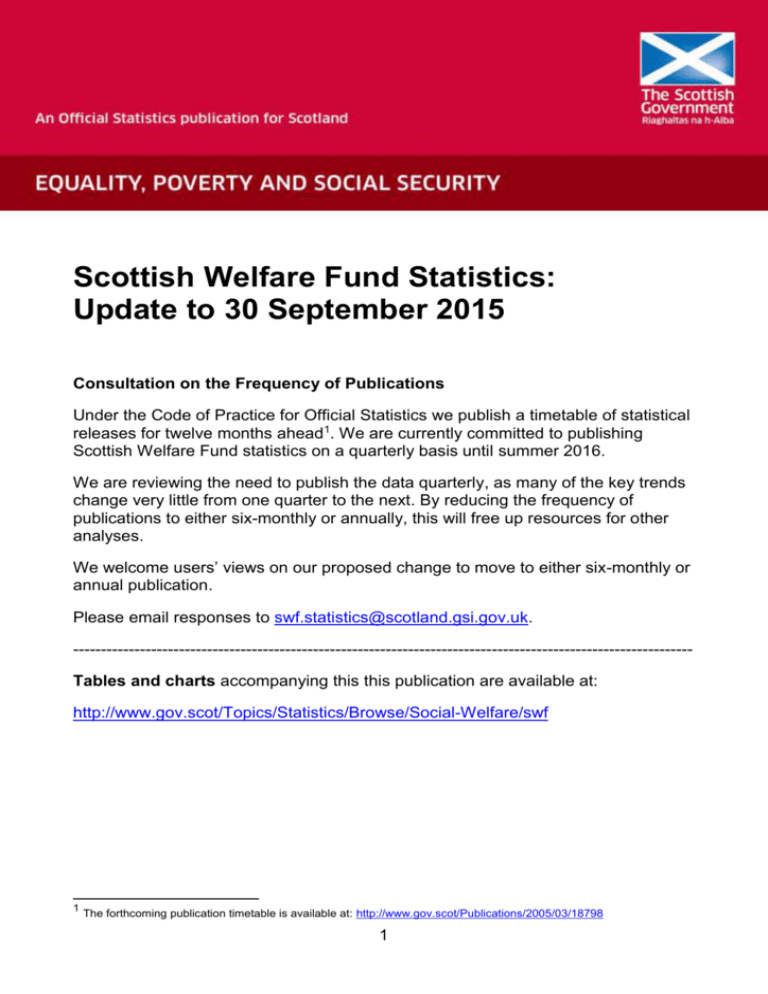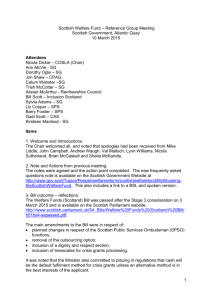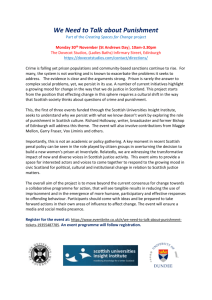Open - The Scottish Government
advertisement

Scottish Welfare Fund Statistics: Update to 30 September 2015 Consultation on the Frequency of Publications Under the Code of Practice for Official Statistics we publish a timetable of statistical releases for twelve months ahead1. We are currently committed to publishing Scottish Welfare Fund statistics on a quarterly basis until summer 2016. We are reviewing the need to publish the data quarterly, as many of the key trends change very little from one quarter to the next. By reducing the frequency of publications to either six-monthly or annually, this will free up resources for other analyses. We welcome users’ views on our proposed change to move to either six-monthly or annual publication. Please email responses to swf.statistics@scotland.gsi.gov.uk. --------------------------------------------------------------------------------------------------------------Tables and charts accompanying this this publication are available at: http://www.gov.scot/Topics/Statistics/Browse/Social-Welfare/swf 1 The forthcoming publication timetable is available at: http://www.gov.scot/Publications/2005/03/18798 1 Introduction This publication provides information on the Scottish Welfare Fund for the latest quarter, 1st July to 30 September 2015. It also contains information from previous financial years dating back to 1 April 2013, when the scheme commenced its operation. These statistics are being published as experimental statistics. Experimental statistics are defined in the Code of Practice for Official Statistics as "new official statistics undergoing evaluation. They are published in order to involve users and stakeholders in their development and as a means to build in quality at an early stage." These statistics have not yet been assessed by the UK Statistics Authority. They have not been designated as National Statistics2. As many of the key quarterly figures change very little from one quarter to the next, this quarterly publication is a short commentary on the statistics covering the main points. Electronic versions of this document and tables are available at: http://www.scotland.gov.uk/Topics/Statistics/Browse/Social-Welfare/swf 2 For more information on experimental statistics please see: http://www.statisticsauthority.gov.uk/news/assessment-and-designation-of-experimental-statistics.html 2 Contents Scottish Welfare Fund Statistics: Update to 30 September 2015 ....................... 1 Introduction .............................................................................................................. 2 Background to the Scottish Welfare Fund ............................................................ 4 Summary of Main Points ......................................................................................... 6 About the Data ......................................................................................................... 9 How the data is collected ....................................................................................... 9 Data Quality ........................................................................................................... 9 Change of Methodology ...................................................................................... 10 Data Specification ................................................................................................ 11 Calculation of Households ................................................................................... 11 Comparisons with other UK Statistics ................................................................. 11 3 Background to the Scottish Welfare Fund On 1 April 2013, the Department for Work and Pensions (DWP) abolished two elements of the Social Fund - Community Care Grants and Crisis Loans - and transferred funds previously spent on them to Scottish Ministers. In its place, the Scottish Government established the Scottish Welfare Fund. The Scottish Welfare Fund is a national scheme run by local authorities, based on guidance from Scottish Ministers. The guidance has been developed in partnership with COSLA, Local Authorities and other stakeholders. The guidance takes previous Social Fund rules as the starting point but has important differences and takes Scottish priorities into account. The Scottish Welfare Fund aims to take advantage of the opportunity to strengthen links to other local services and provide a better service to vulnerable members of the local community. The objectives of the new scheme are to: provide a safety net in a disaster or emergency, when there is an immediate threat to health or safety. enable people to live independently or continue to live independently, preventing the need for institutional care. There are two types of grants in the Scottish Welfare Fund – Crisis Grants, and Community Care Grants. A Crisis Grant aims to help people on a low income, who are in crisis because of a disaster or an emergency. A disaster is something like a fire or a flood. An emergency might be needing to travel to visit a sick child or when money has been stolen. A Community Care Grant aims to: help people establish themselves in the community following a period of care, where circumstances indicate that there is a risk of the person not being able to live independently without this help; help people remain in the community rather than going in to care where circumstances indicate that there is a risk of the person not being able to live independently without this help; help people set up home in the community, as part of a planned resettlement programme, following an unsettled way of life; help families facing exceptional pressures, with one-off items, like a cooker or a washing machine, and; help people to care for a prisoner or young offender on release on temporary licence. 4 The Scottish Welfare Fund is a discretionary, budget-limited scheme that prioritises applications according to need. It provides grants that do not have to be repaid. It does not provide loans. The DWP transferred the funding spent in Scotland on its Community Care Grants and Crisis Loans for Living Expenses to the Scottish Government. For 2013/14 and 2014/15 this amounted to £23.8 million per year. The Scottish Government topped this amount up by a further £9.2 million, giving the Scottish Welfare Fund a total budget of £33 million for 2013/14 and 2014/15. This funding level has been maintained by the Scottish Government for 2015/16 at £33 million. Local Authorities have been able to top this up with their own funds together with any underspends carried froward from previous years. There is no statutory limit on the amount of money which can be spent on the Scottish Welfare Fund. The Scottish Welfare Fund was introduced on an interim basis, with the intention to learn lessons from the operation of the interim scheme, prior to setting out in law. The Welfare Funds (Scotland) Act 2015 was passed by the Scottish Parliament on 3 March 2015 and received Royal Assent on 8 April 2015. The draft Welfare Funds (Scotland) Regulations 2016 were laid on 16 December 2015, and Statutory Guidance will be in place for the permanent arrangements which come into force from April 2016. Local Authority Delivery Local Authorities have the discretion to provide support in different ways. Not all grants will be cash payments. They may provide vouchers, fuel cards, or goods if they think that is the best way to meet the needs of the applicant. Local Authorities also have discretion on where in their organisation they process applications, and how they link the scheme to existing services. Local provision of Crisis Grants and Community Care Grants allows for a more joined up approach than was possible with the national call centre provision that existed for the Social Fund. By linking to local services (such as budgeting or other money advice, homelessness teams or social services) individuals, families and communities will be able to manage better in the longer term. 5 Summary of Main Points Applications During July to September 2015, a total of 51,200 applications to the Scottish Welfare Fund were received. These included 17,000 applications for Community Care Grants and 34,800 applications for Crisis Grants. NB. Households can apply for both Community Care Grants and Crisis Grants in the same application. (Table 1, Table 2 & Table 3) Comparing July to September 2015 with the same quarter one year ago, applications for Community Care Grants decreased by 900 applications (-5%), whilst applications for Crisis Grants decreased by 1,100 applications (-3%). (Table 2 and Table 3) The rate of repeat applications for Community Care Grants was 25% during July to September 2015, an increase of three percentage points compared to one year ago. These are applications where the household also applied within the previous 12 months. (Chart 25) Over this same period, for Crisis Grants, the rate of repeat applications has remained at around 50%. (Chart 25) Processing Times During 1 July to 30 September 2015: 94% of Community Care Grant applications were processed within the 15 working day limit, an increase of thirteen percentage points compared to the same quarter one year ago.(Table 10) 97% of Crisis Grant applications were processed within the two working day limit. This is unchanged compared to the same quarter one year ago. (Table 12) SWF Budgets for 2015/16 Local Authorities have around £35.3 million to spend on the Scottish Welfare Fund during 2015/16 and this is around £2.1 million less (-6%) compared to 2014/15. (Table 25). Whilst Scottish Government funding for the Scottish Welfare Fund has remained the same as in previous years at £33 million – the same as in the previous two financial years – the actual amount that Local Authorities have to spend in 2015/16 varies as a consequence of underspends being carried forward Due to the initial slow start of the Scottish Welfare Fund, the budget for 2014/15 was supplemented by a £4.4 million underspend carried forward from 2013/14. By the end of 2014/15, an underspend of £2.0 million remained. In 2015/16, with one Local Authority topping up its budget by £300,000 from its own General Fund, the total amount of funding available for the Scottish Welfare Fund is around £35.3 million. Overall, the total amount available to spend through the Scottish Welfare 6 Fund has increased in seven Local Authorities – their underspends increased between 2013/14 and 2014/15 - and reduced in 25 local authorities. Expenditure and Awards During 1 July to 30 September 2015: 17,200 Community Care Grant applications were decided and in 10,900 cases, a decision to make an award was made (Table 14). Overall, 63% of cases were successful (a two percentage point increase from the same quarter last year) (Table 16). During the quarter, Local Authorities awarded £6.2 million in Community Care Grants with an average award value of £566 (Table 14). 34,800 Crisis Grant applications were decided and in 24,700 cases, a decision to make an award was made (Table 17). Overall, 71% of applications were successful (a one percentage point decrease from the same quarter last year) (Table 19). Local Authorities awarded £1.9 million in Crisis Grants with an average award value of £77 (Table 17). A total of £8.1 million was spent through the Scottish Welfare Fund for this quarter (Table 24Q). For 2015/16, as at 30 September 2015: £16 million has been spent up to this quarter (45% of the £35.3 million available for the year) (Table 26). Compared to this same quarter last year, this is 2.5 percentage points lower than what was spent as at 30 September 2014 (48% of the £37.3 million available for 2014/15) (Table 25 and Table 26). Five Local Authorities had spent more than 50% of their funds for the year. These were: Midlothian (57%), Perth & Kinross (55%), Stirling (54%), Renfrewshire (52%) and South Lanarkshire (52%) (Table 26 and Chart 12). Items and Payments For Community Care Grants, the most common expenditure was on floor coverings, white goods, and furniture. For Crisis Grants, most expenditure was on food, essential heating costs and other living expenses (Table 28 and Table 30). The most common methods of paying out Community Care Grants were by providing new goods, cash payments and payments into bank accounts. For Crisis Grants, the most common form of payment was cash and store vouchers (Table 33 and Table 34). 7 Scottish Index of Multiple Deprivation Since the scheme began in April 2013 through to 30 September 2015: Over half of Community Care Grants (53%) and Crisis Grants (51%) were awarded to applicants living in the 20% most deprived datazones in Scotland. The 20% least deprived datazones received 2% of each of these awards (Table 38, Table 39 and Chart 17). The average Community Care Grant was over £100 higher for those in the 20% most deprived datazones (with an average of £638 per award) compared to those in the 20% least deprived datazones (with an average of £512 per award) (Chart 17). Crisis Grant awards had an average award value of £74 per award over this period, for both the 20% most and 20% least deprived datazones (Chart 17). Reviews For Community Care Grants, since the scheme began in April 2013 through to 30 September 2015, there were around 8,000 tier 1 reviews, and the original decision was revised in 47% of cases. At tier 2, there were around 700 reviews and 41% of these reviews revised the original decision. (Table 35a) Over the same period, for Crisis Grants a total of around 2,700 tier 1 reviews were received. Decisions were revised in 46% of tier 1 reviews. There were around 200 tier 2 reviews for Crisis Grants, of which 50% revised the original decision. (Table 35a) Characteristics of Households in Receipt of Awards Since the scheme began in April 2013 through to 30 June 2015, almost 178,000 unique households received at least one award from the Scottish Welfare Fund. Of these, 88,600 unique households received a Community Care Grant and 123,100 unique households received a Crisis Grant (Table 40a). Over half of households in receipt of funds (54%) were single person households with no children. Around one third of households in receipt of funds (33%) contain children (Table 40a). Repeat Awards During the quarter July to September 2015, 16% of Community Care Grant awards were repeat awards – that is, made to a household which had been awarded a Community Care Grant within 12 months of the current award. This was two percentage points higher than the same quarter one year ago. The corresponding figure for Crisis Grants was 50% - almost unchanged on one year ago (Chart 25). 8 About the Data How the data is collected One month after the end of each quarter, Local Authorities are asked to submit an XML file containing the information as set out in the data specification. This data is then uploaded to the Scottish Government’s ProcXed website. Once the data has been validated by our software, the data is passed over to the Scottish Government’s Communities Analytical Services. Four IT companies provide IT systems which underpin the provision of the Scottish Welfare Fund. These companies are Capita, Civica, Northgate IS and IEG4. Data Quality To ensure the data we receive is of the highest quality, we have asked all IT providers to implement the data specification as fully as possible. The data specification includes a number of validations. These validations are provided through an XSD schema and have also been implemented into the ProcXed system. Once local authorities submit data to the ProcXed system, a number of validations are triggered and warning messages appear. Local authorities may resubmit data to fix these errors or they can comment them to explain why they believe the data to be valid. On submission of the data to the Scottish Government, each local authority is sent a detailed automatic report showing the contents of the data and any remaining errors. To ensure sufficient data has been submitted, we cross check all submitted data with the informal monitoring returns submitted to the Scottish Government. The automatic reports sent to local authorities contain charts which allow them to easily see if there is a discrepancy between these two data sources. Known data issues are as follows: An application is included in the quarterly data extract to the Scottish Government only when an application has been decided and when a payment has been made. For Crisis Grants, applications are less complex and payments are made quickly, resulting in almost no lag between cases being decided and being included in the data extract. However, for Community Care Grants, a large number of items may need to be ordered and payment may not occur until up to one month later, when invoices arrive. This results in a lag time between applications beginning in the local authority and applications being included in the extract to the Scottish Government. To rectify this problem, we are asking local authorities to submit data one to two months after the end of the quarter. This will ensure that, as far as possible, all relevant cases are included in the data extract. Some Local Authorities have experienced backlogs in entering data into their IT systems. As dates are automatically system generated, late entry of data has a knock on effect on any calculation which involves processing times or payment times. 9 Some Local Authorities may not have been able to enter all of their data in time to include in this publication. Late entry of data may mean that this data appears in subsequent quarters, rather than in the quarter when the case was actually dealt with. Some question responses may default to “Other” in some IT systems. We are currently working with IT providers to ensure that the full range of questions and responses are available in all local authority IT systems. Some questions may not be completed at all. This includes the vulnerability and referrals questions for some local authorities. We are actively working with local authorities to improve the quality of data collected. From August 2014 we have begun issuing a one page summary document to data providers which compares the completion of different questions across local authorities. In this way, we have identified issues common to IT systems and which issues are Local Aauthority specific. This exercise is being repeated quarterly. We also received reconcilliations from Local Authorities. For example, Local authorities may estimate the cost of carpets and the final invoice for these may be less than originally thought. This results in money being being paid back into their systems. Over time, the expenditure data in the quarterly monitoring may exceed monies actually spent if reconcilliations are not applied. Most recently, a reconciliation exercise has been completed with South Lanarkshire Council, resulting in their reported quarterly monitoring expenditure being reduced by around £450k (9%) for the period to June 2015. Change of Methodology Some figures have changed slightly since the last publication due to a change in methodology. If a case had been reviewed, expenditure was originally assigned to the quarter of the review date. This meant that expenditure could shift into a subsequent quarter or financial year, depending on whether a review had taken place. After feedback from Local Authorities, all expenditure has now been assigned to the date of the initial decision. 10 Data Specification The data specification for the Scottish Welfare Fund is available at: http://www.scotland.gov.uk/Topics/Statistics/15257/1529/swf-dataspec Guidance to help local authority officers to record information is available at: http://www.scotland.gov.uk/Topics/Statistics/15257/1529/swf-data-guidance Calculation of Households We collect information on all people within each application. To group people into household units we filter the people table to contain only the main applicant and their partner. We ensure that there is no more than two people for each application. We generate a unique household reference based on the hashed National Insurance Number, gender and date of birth of the main applicant, and if applicable, their partner. Comparisons with other UK Statistics Annual reports by the Secretary of State for Work and Pensions on the Social Fund for the period prior to 1st April 2013 are available from the Department for Work and Pensions. The most recently available report can be found at: https://www.gov.uk/government/publications/annual-report-by-the-secretary-of-state-for-work-andpensions-on-the-social-fund-2012-to-2013 In addition, data on Discretionary Social Fund applications, awards and expenditure by Local Authority from April 2012 to March 2013 can be found at: https://www.gov.uk/government/statistics/discretionary-social-fund-by-local-authority-apr-2012-tomar-2013 On 1st April 2013, the Department for Work and Pensions devolved the responsibility for Community Care Grants and Crisis Loans to the Scottish Government, the Welsh Government and directly to English local authorities. As a single national scheme covering the UK is no longer in operation, comparable statistics for other parts of the UK are not available. 11 An Official Statistics publication for Scotland Official and National Statistics are produced to high professional standards set out in the Code of Practice for Official Statistics. Both undergo regular quality assurance reviews to ensure that they meet customer needs and are produced free from any political interference. Correspondence and enquiries For enquiries about this publication please contact: Kim Reimann Social Security and Housing Access Statistics Telephone: 0131 244 7232 e-mail: kim.reimann@gov.scot For general enquiries about Scottish Government statistics please contact: Office of the Chief Statistician, Telephone: 0131 244 0442, e-mail: statistics.enquiries@scotland.gsi.gov.uk How to access background or source data The data collected for this <statistical bulletin / social research publication>: ☐ are available in more detail through Scottish Neighbourhood Statistics ☒ are available via an alternative route. Summary tables are available at: http://www.scotland.gov.uk/Topics/Statistics/Browse/Social-Welfare/swf ☒ may be made available on request, subject to consideration of legal and ethical factors. Please contact andrew.waugh@scotland.gsi.gov.uk for further information. ☐ cannot be made available by Scottish Government for further analysis as Scottish Government is not the data controller. Complaints and suggestions If you are not satisfied with our service or have any comments or suggestions, please write to the Chief Statistician, 3WR, St Andrews House, Edinburgh, EH1 3DG, Telephone: (0131) 244 0302, e-mail statistics.enquiries@scotland.gsi.gov.uk. If you would like to be consulted about statistical collections or receive notification of publications, please register your interest at www.gov.scot/scotstat Details of forthcoming publications can be found at www.gov.scot/statistics Crown Copyright You may use or re-use this information (not including logos) free of charge in any format or medium, under the terms of the Open Government Licence. See: www.nationalarchives.gov.uk/doc/open-government-licence/ 12








